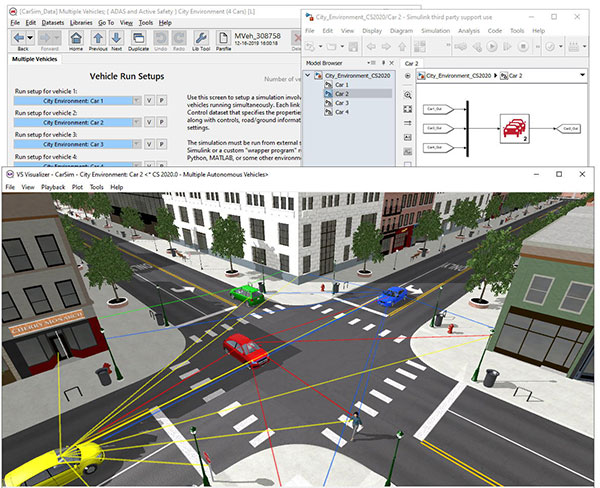Mechanical Simulation Releases CarSim, TruckSim, BikeSim and SuspensionSim 2020.0
The math models run fast enough to support real-time simulation with hardware in the loop (HiL) and can support massive optimization projects involving hundreds of thousands of simulations, the company reports.

Image courtesy of Mechanical Simulation.
Latest News
February 7, 2020
Mechanical Simulation releases the 2020.0 versions of the vehicle simulation tools CarSim, TruckSim, and BikeSim and the suspension simulation tool SuspensionSim. The VehicleSim products CarSim, TruckSim and BikeSim have long featured high-fidelity math models for vehicle dynamics that can reproduce physical test results.
The math models run fast enough to support real-time simulation with hardware in the loop (HiL) and can support massive optimization projects involving hundreds of thousands of simulations, the company reports.
As with past upgrades, the VehicleSim products have significant new features. Version 2020.0 includes built-in support for electrified powertrains, improved tools for making use of external data, refined capabilities for advanced driver assistance systems (ADAS) and autonomous vehicle (AV) technologies, and new features in support of high-performance computing (HPC) environments.
The VehicleSim simulation tools have been extended to offer additional support. VS Terrain is used for importing road data from a wide variety of sources including GPS and FBX. VS Terrain has been improved to clean up noisy data and reduce file sizes to allow more complicated environments to be used in real-time testing.
The improvement in efficiency allow it to be supported on multiple HiL platforms. The addition of a command line interface (CLI) helps automate the pipeline of converting terrain data to VS Terrain file format.
Mechanical Simulation’s drag-and-drop environment building software, VS Scene Builder, has been improved to more easily switch between Right- and Left-hand drive roads. This release also adds support for OpenDrive 1.5.
AV development demands more than a single vehicle operating in an environment. For that reason, a function was added to VehicleSim to setup multiple fully detailed ego vehicles in a single simulation. This is useful for applications like platooning and vehicle interaction examples.
Multiple ego vehicle support can now be run on some HiL platforms. In the world of AV development, Linux is the preferred platform. For this reason, 2020.0 makes helps create feature parody between the VehicleSim products running on Windows and Linux.
VehicleSim now supports these utilities on Linux: VS Connect for asynchronous data synchronization between the Unreal and Simulink environments, VS Visualizer for animations and plots, VS Terrain for making use of external terrain data, Vehicle API for using the vehicle math
models with other software, Unreal Plugin for advanced animations, and Docker recipes for scalable deployment to larger clusters.
V development means running millions of miles of simulation whenever changes have been made. HPC clusters are the best answer for this problem. VehicleSim has improved support for HPC in the form command line interface (CLI), support for Docker, and improved license management designed for this use case.
Mechanical Simulation is supporting even more external software and data, especially with tools that provide complicated 3D road networks and intersections, and with tools that provide advanced visualization and sensing.
“Over the past 25 years, VehicleSim has transformed from a vehicle dynamics software to a simulation test environment,” notes Dr. Michael Sayers, CEO and chief technology officer. “With the release of 2020.0 VehicleSim products are more scalable, easier to manage, and more extensible. It has never been easier to put massive simulation power in the hands of engineers.”
Sources: Press materials received from the company and additional information gleaned from the company’s website.
Subscribe to our FREE magazine, FREE email newsletters or both!
Latest News
About the Author
DE’s editors contribute news and new product announcements to Digital Engineering.
Press releases may be sent to them via [email protected].






